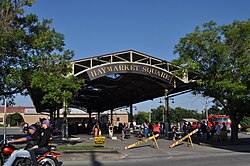 Saloons served customers such as fur trappers, cowboys, soldiers, prospectors, miners, and gamblers. The first saloon was established at Brown's Hole, Wyoming, in 1822, to serve fur trappers.
By the late 1850s the term saloon had begun to appear in directories
and common usage as a term for an
Saloons served customers such as fur trappers, cowboys, soldiers, prospectors, miners, and gamblers. The first saloon was established at Brown's Hole, Wyoming, in 1822, to serve fur trappers.
By the late 1850s the term saloon had begun to appear in directories
and common usage as a term for an  establishment that specialized in beer
and liquor sales by the drink, with food and lodging as secondary
concerns in some places. By 1880, the growth of saloons were in full swing. In Leavenworth, Kansas
establishment that specialized in beer
and liquor sales by the drink, with food and lodging as secondary
concerns in some places. By 1880, the growth of saloons were in full swing. In Leavenworth, Kansas there were "about 150 saloons and four wholesale liquor houses"
there were "about 150 saloons and four wholesale liquor houses"Saloons in America began to have a close association with breweries in the early 1880s. With a growing overcapacity, breweries began to adopt the British “tied-house” system of control where they owned saloons outright. Brewers purchased hundreds of storefronts, especially on the highly desired corner locations, which they rented to prospective saloon keepers, along with furnishings and
Legislative factors also played a factor in the growth of brewery owned saloons. The Chicago City Council increased the saloon license from $50 to $500 between 1883 and 1885 to pay for an expanded police force made necessary by the barrooms. Relatively few independent proprietors could afford to pay such amounts.
Politicians also frequented local saloons because of the adaptable social nature of their business. In neighborhoods where literacy was low, the bar provided the principal place for the exchange of information about employment and housing. A savvy politician could turn his access to resources into votes. In factory districts, saloons became labor exchanges and union halls, as well as providing a place to cash paychecks.
Beginning in 1893, the Anti-Saloon League began protesting against American saloons. In 1895 it became a national organization and quickly rose to become the most powerful prohibition lobby in America, pushing aside its older competitors the Woman's Christian Temperance Union and the
 Prohibition Party.
The League lobbied at all levels of government for legislation to
prohibit the manufacture or import of spirits, beer and wine. Ministers
had launched several efforts to close Arizona saloons after the 1906 creation of League chapters in Yuma,
Prohibition Party.
The League lobbied at all levels of government for legislation to
prohibit the manufacture or import of spirits, beer and wine. Ministers
had launched several efforts to close Arizona saloons after the 1906 creation of League chapters in Yuma, Tucson,
Tucson, and Phoenix. League members pressured local police to take licenses
from establishments that violated closing hours or served women and
minors, and they provided witnesses to testify about these
and Phoenix. League members pressured local police to take licenses
from establishments that violated closing hours or served women and
minors, and they provided witnesses to testify about these The traditional saloon was declining many years before Prohibition. The automobile took patronage away from the pedestrian institution. Nickelodeons also competed for the entertainment niche. An increasing numbers of employers demanded abstinence during the workday. City health departments also enacted regulations that eliminated many features of the free lunch table. Finally, World War I brought not only an attack on anything that seemed remotely German but also a temporary ban on brewing.

No comments:
Post a Comment